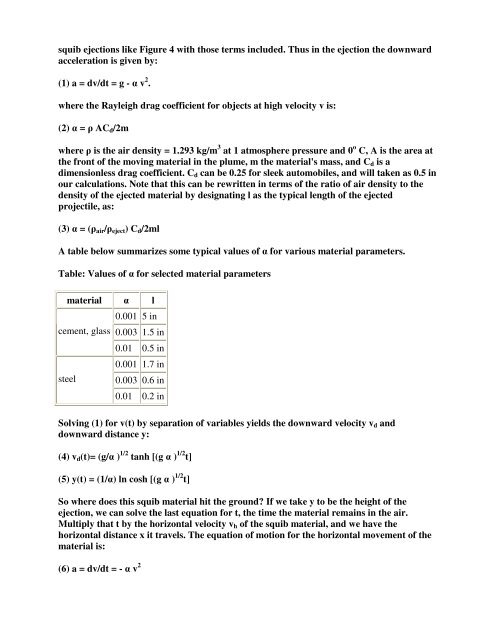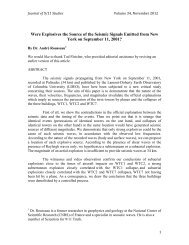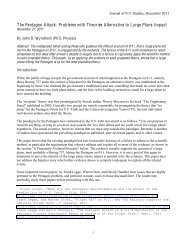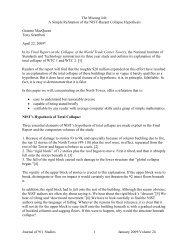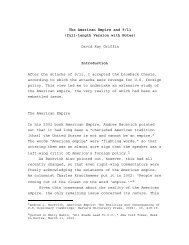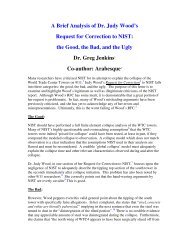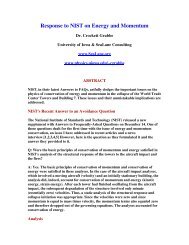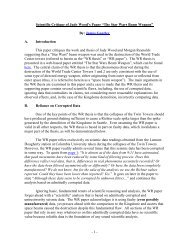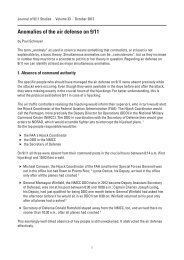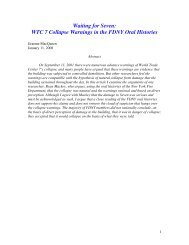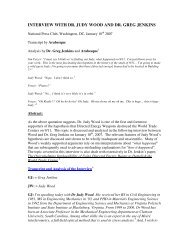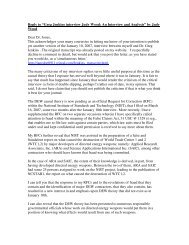Direct Evidence for Explosions - Journal of 9/11 Studies
Direct Evidence for Explosions - Journal of 9/11 Studies
Direct Evidence for Explosions - Journal of 9/11 Studies
You also want an ePaper? Increase the reach of your titles
YUMPU automatically turns print PDFs into web optimized ePapers that Google loves.
squib ejections like Figure 4 with those terms included. Thus in the ejection the downward<br />
acceleration is given by:<br />
(1) a = dv/dt = g - α v 2 .<br />
where the Rayleigh drag coefficient <strong>for</strong> objects at high velocity v is:<br />
(2) α = ρ AC d /2m<br />
where ρ is the air density = 1.293 kg/m 3 at 1 atmosphere pressure and 0 o C, A is the area at<br />
the front <strong>of</strong> the moving material in the plume, m the material's mass, and C d is a<br />
dimensionless drag coefficient. C d can be 0.25 <strong>for</strong> sleek automobiles, and will taken as 0.5 in<br />
our calculations. Note that this can be rewritten in terms <strong>of</strong> the ratio <strong>of</strong> air density to the<br />
density <strong>of</strong> the ejected material by designating l as the typical length <strong>of</strong> the ejected<br />
projectile, as:<br />
(3) α = (ρ air /ρ eject ) C d /2ml<br />
A table below summarizes some typical values <strong>of</strong> α <strong>for</strong> various material parameters.<br />
Table: Values <strong>of</strong> α <strong>for</strong> selected material parameters<br />
material α l<br />
cement, glass<br />
steel<br />
0.001 5 in<br />
0.003 1.5 in<br />
0.01 0.5 in<br />
0.001 1.7 in<br />
0.003 0.6 in<br />
0.01 0.2 in<br />
Solving (1) <strong>for</strong> v(t) by separation <strong>of</strong> variables yields the downward velocity v d and<br />
downward distance y:<br />
(4) v d (t)= (g/α ) 1/2 tanh [(g α ) 1/2 t]<br />
(5) y(t) = (1/α) ln cosh [(g α ) 1/2 t]<br />
So where does this squib material hit the ground If we take y to be the height <strong>of</strong> the<br />
ejection, we can solve the last equation <strong>for</strong> t, the time the material remains in the air.<br />
Multiply that t by the horizontal velocity v h <strong>of</strong> the squib material, and we have the<br />
horizontal distance x it travels. The equation <strong>of</strong> motion <strong>for</strong> the horizontal movement <strong>of</strong> the<br />
material is:<br />
(6) a = dv/dt = - α v 2


